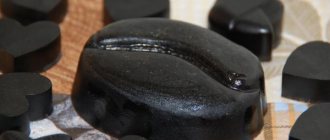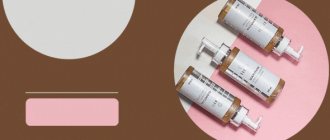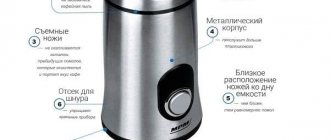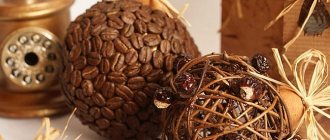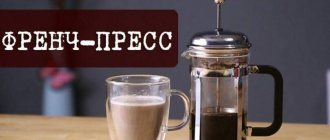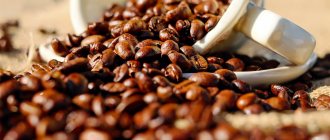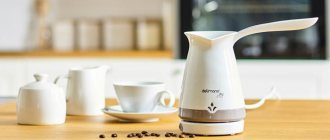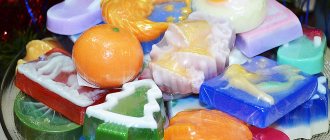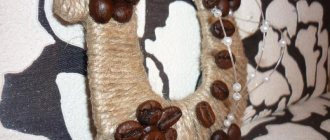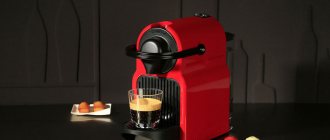A homemade filter for a coffee maker allows you to brew a tasty and aromatic drink at minimal cost. When selecting materials, the characteristics of the equipment should be taken into account. It is not recommended to use homemade products on a regular basis, since their filtering capabilities are inferior to those of factory products, and small particles of beans clog the coffee maker and disable the equipment.
Filters for coffee makers - varieties
True coffee connoisseurs know that its taste depends not only on the quality of the ground beans, but also on the filtration of the finished drink. Coffee maker filters are made from a variety of materials. They have different characteristics and costs.
Paper
The most popular type of filter, which has been used for more than 100 years. In production, both unbleached brown paper sheets and white ones are used. Brown products that are not bleached and do not have glue in the seams are considered the most environmentally friendly. However, they can impart a cardboard taste to the drink. White paper has no foreign odor.
The most expensive and high-quality products are made from bamboo.
Bamboo fibers ensure high purity of the finished drink and have no odor. The cost of such filters is high.
The main advantages of paper filters include:
- The porous, dense material traps even the smallest solid particles, filters natural alkaloid compounds and oily diterpenes, which contribute to increasing cholesterol levels in the human body.
- Used disposable paper products are discarded, preventing the possibility of fungi developing like reusable filters.
- They have a long shelf life.
- The installation and removal process is very simple.
- Used filters quickly decompose and do not harm the environment.
The main disadvantages include only the need to regularly purchase filters. When preparing a coffee beverage frequently, the cost of paper filtration can be significant.
Nylon
Some models of coffee makers have a plastic or metal cone covered with nylon as a filter element. Synthetic fibers are durable, hypoallergenic, and have a long service life. Reusable nylon filters can be used at least 60 times. The average cost per application is low.
The smallest particles of ground beans penetrate through the nylon mesh, so it is recommended to use medium and coarse grind coffee. The filtered grounds are immediately cleaned off, which increases the time required to prepare a cup of aromatic coffee.
Gold
Some manufacturers coat filter frame elements with nylon mesh with titanium nitride. The result is a product with a metallic golden sheen. The titanium coating increases the service life of the filter and makes it easier to clean.
Relative disadvantages include the high cost of the products and the inability to prepare a drink from finely powdered coffee. To maintain the hygiene of the filter, it must be thoroughly cleaned of grounds particles.
Fabric
In the production of fabric models, cotton, muslin or hemp fabrics are used. Textile fibers, when interwoven, form large pores, which allows some of the grounds to leak into the cup. Fabric filters are reusable and have a shelf life of no more than 180 days if used daily.
The disadvantages include the rapid loss of attractive appearance, since coffee darkens the fibers of the fabric.
Cleaning must be thorough and timely. Textile filter elements are affordable.
Metal
The products are distinguished by their strength and durability. Most often, metal filters are made of stainless steel. The service life is unlimited, the risk of mechanical damage is minimal. Both manual cleaning and dishwasher cleaning are allowed.
The stainless steel mesh does not retain aromatic oils or alkaloid derivatives. The drink is strong, with a small amount of grounds at the bottom. From an environmental point of view, metal filters are optimal because they do not require regular replacement.
Historical reference
The paper filter was invented by a German housewife from the city of Dresden, Melitta Benz. At the beginning of the last century, she came up with an unexpected way to filter coffee using an ordinary blotter from a school notebook, which was simply inserted into a pot with holes.
In 1908, an enterprising woman received a patent for a coffee filter with micropores and, with a starting capital of seventy-three pfennigs, she and her husband created a production facility for their production. Today the Melitta brand is a leader in the production of similar products.
Ceramic and metal devices for retaining grounds were known long before Melitta's invention. The canvas was used as a filter. The very first production existed in a woman’s apartment on eight square meters. After some time, the husband hires several workers, and the family is engaged only in the production and sale of these devices. The paper for the products was supplied by the sons, the husband showed the filtration method in the apartment window, and Melitta was the administrator and advertised the drink among friends, organizing coffee breakfasts.
The second generation owners, the grandchildren of Melitta Benz, placed their bets on bringing their products to the world market.
The Melitta brand, having conquered the filter paper and coffee filter segment in Germany, paid attention to expanding the sales market in other countries. However, the Second World War made its own adjustments
Having experienced difficulties, ]Melitta still survived. In the fifties of the last century, sales increased to four and a half million German marks.
Currently, Ms. Benz's grandchildren occupy the positions of general partners of the holding's management.
Return to content
Selecting filters by size
The main criterion for choosing a suitable product is the expected yield of the finished product. To prepare 1 serving, filter No. 1 is sufficient. If you need to make more coffee, then choose products for 2, 4 or 6 servings.
Filters 4 and 2, the difference between which is throughput, are the most popular. For a coffee maker flask with a volume of 0.6-0.8 liters, filter No. 2 is intended. If the flask volume is 1 - 1.2 liters, you should select filter No. 4. Some manufacturers offer models for preparing 8-12 servings of the drink.
Wine glass
Are you surprised? But this is true. The most ordinary wine glass can serve as an excellent light filter to achieve simply stunning photographic effects! Let's first fill a glass with clean water and look through it. Thanks to an optical phenomenon called refraction, in a glass we will see an inverted image of what is behind it.
Photographing through a wine glass filled with water can create a wonderful series of photos!
How to take photographs with such an unusual filter? It's not difficult at all. We place a glass filled with water in front of the lens on some plane (table, chair, window sill, on a stump in the forest...), focus and start shooting. You need to focus on the image that will be visible on the surface of the glass. We recommend this type of shooting in aperture priority mode. The aperture needs to be opened wider. A wide open aperture allows us to get shallow depth of field, which in turn allows us to get good foreground sharpness while keeping the background nicely blurred.
Well, after you finish the photo shoot through a wine glass filled with water, in the process of post-processing the image on the computer, the picture can be turned 180 degrees, that is, in other words, put it upside down. Now, from the point of view of human perception, the image will be correct.
How to make your own filter
In an emergency or to save money, it is possible to make a paper filter element with your own hands.
The main thing is the right choice of material. Office paper will not allow water to pass through well; thin newspaper paper may dissolve or tear. Towels, multi-layer napkins and paper handkerchiefs have maximum porosity and high filtering ability.
Here is the algorithm of actions:
- Choose a napkin or piece of towel without inscriptions or drawings. Dyes will dissolve with hot water and end up in the finished coffee, which is harmful to health.
- Draw a circle with a diameter of about 15 cm and cut it along the contour.
- The cut out circle is folded in half, then doubled again.
- Ground coffee is poured inside the resulting funnel.
- The filled filter is fixed in a funnel or used when brewing a drink in a cup.
It is also possible to make a durable filter element at home from fabric. Preference is given to cotton fabric of medium thickness. The washed cloth will filter the drink faster. An alternative material is gauze, medical bandage, and nylon products. These fabrics will need to be folded in several layers.
Water is leaking from under the horn
If you find that the coffee machine is leaking at the junction of the horn and the body, this is not a very serious malfunction that can be easily repaired with your own hands. Most likely, water is flowing due to the fact that the sealing ring at the junction of the so-called “spout” and the body of the coffee machine is clogged. Clogging can occur due to anything: fat deposits, wet pulp, coffee, foreign objects, etc. In this case, to repair you only need to wash the contaminated area and reassemble the horn.
If the coffee machine is leaking because the seal is damaged (cracked or torn), you need to replace it with a new one.
Here you should draw your attention to the fact that it is necessary to replace the o-ring with one with exactly the same characteristics. If you simply find a similar shaped seal in your home workshop (for example, from a car part), you don’t need to install it, because
the rubber from which such a product can be made may not be sufficiently resistant to temperatures or not so elastic. The same requirement applies to other consumables!
How to fix a leak yourself
We also draw your attention to the fact that when repairing a coffee machine like this yourself, you need to check the filter of the horn before installing a new seal. Perhaps the filter is clogged with coffee deposits and the breakdown occurred due to the fact that pressurized water was looking for a weak point of the breakthrough
If the filter is not cleaned on time, more serious problems may occur.
By analogy, you can repair or replace any other oil seal that is leaking. Did you see water running out of the coffee machine? Don't be afraid to repair the problem area yourself. The main thing is to do this in time, before the water reaches the wiring and electronic unit. Timely repairs can protect you from electric shock and your equipment from complete failure. It should also be noted that the opposite situation - when the coffee machine does not pump water, can occur due to a malfunction of the piston located above the brewer. You can also try to repair it yourself after a visual inspection.
Common problems when using homemade filters
Home-made filters cannot completely replace professional ones. With regular use, you may encounter some difficulties:
- the fibers of fabric models become more porous when reused. They absorb more oils, and the drink loses its strength and aroma;
- if textiles are washed using soap or powder, the taste of the coffee deteriorates;
- When using new gauze or bandage, an unpleasant medical aftertaste may occur in the finished drink.
Homemade filter elements are not recommended for permanent use.
Glowsticks
Another very original way to get an interesting and unusual photographic image is to use glow sticks when shooting. They will add a colorful rainbow to your pictures. Portraits taken this way are especially interesting. To create this “light filter”, glow sticks need to be activated and attached in front of the lens, lengthwise or crosswise, as you wish. You can use one stick or several. Experience shows that the smaller the glow sticks, the better the effect they give in the photo.
The easiest way to attach glow sticks to the lens is with adhesive tape.
This must be done very carefully. At the same time, try not to damage the lens or dirty its front lens.
Don't forget to also ensure that the glow sticks attached to the lens do not interfere with your ability to rotate the zoom ring and the focusing ring.
Well, here are all the types of original and unusual light filters that we wanted to tell you about today. Of course, your camera, equipped with such unusual accessories, may cause smiles from others. But, you see, your main goal is to get interesting and unusual photos! What is more important to you? The end result or the reaction of your friends to the process of your work? Decide for yourself. Let us just note that in the old days, some photographers, instead of Vaseline, used... the contents of their own nose, applied to a neutral density filter screwed onto the lens. Yes Yes! They will pick their nose with their finger, and then wipe their finger not on a handkerchief, but on a light filter.
Filter for coffee machines Jura, Bosch, Saeco, Delonghi
Depending on the configuration of the coffee machine, it uses a metal, nylon filter element with a long service life, or disposable models. To replace a reusable filter cone, you should give preference to original components or study its characteristics and consider universal models.
Popular manufacturers of paper filters are Filtero, Melitta, Aksel KONOS, Topperr. The products are made from high quality materials and are suitable for drip coffee makers of standard models Jura, Bosch, Saeco, Delonghi. Purchase paper filter elements in packs of 40-240 pieces. It is possible to install a disposable filter without special skills.
What is espresso?
Espresso is the Italian answer to your immediate caffeine need.
The word itself conveys the very essence contained in this drink. That's right, it cooks instantly in an espresso machine and this shot needs to be drunk instantly. What else is special? For example, the fact that it is brewed at high temperatures (almost boiling!), and under high pressure water passes through finely ground coffee. Espresso is denser and more concentrated than filter coffee.
Shot of espresso in the process of preparation.
In addition to the fact that espresso is consumed in its pure form, it also serves as the basis for the preparation of many delicious drinks, such as Americano, cappuccino, flat white, latte. Their difference is in the amount of frothed milk or hot water added.
Latte and latte art.
Which ones to choose and how often to change?
If you can choose to use a disposable or reusable filter element in a coffee machine, then take into account their features:
- Replaceable ones are highly hygienic, but they need to be purchased regularly. The product is used once and then disposed of.
- Reusable ones will last at least 6 months, but if not properly cleaned, they can accumulate harmful bacteria in the cells.
- The cost of preparing a serving of coffee in a machine with reusable cleaning is cheaper. But it will take time to clean them regularly.
The average cost of packaging 100 paper products is about 300 rubles. Nylon ones cost from 400 rubles. Original metal models are the most expensive, their cost exceeds 2000 rubles.
Regardless of the chosen filter element model, you should not save money; low-quality products allow harmful substances to pass through and worsen the taste of the drink. When choosing, you should also consider personal preferences. If you drink strong coffee with a little sediment, then choose nylon or fabric. The choice of product size is made based on the expected volume of the finished drink and the capacity of the machine’s flask.
Cellophane
Yes Yes! An ordinary plastic bag in which they put two hundred grams of sausage for breakfast at the supermarket! Of course, to create a light filter we need a clean, unused bag. But is it really a problem to find one on your farm? A light filter from an ordinary plastic bag can be used to simulate an overexposed frame (the so-called light leak effect). Or you can color the cellophane in one way or another.
So, we take cellophane of any color we like. We cut off a piece of the size we need and use an elastic band to attach it to the lens of our camera. That's all, actually. Our filter is ready for use. Look through the camera viewfinder to see if the piece of cellophane is lying flat. Smooth? Let's start filming!
With such a cellophane filter you can cover the entire lens, or you can cover half of its front lens or even a small part. You can make a combination of pieces of cellophane of different colors. To obtain an interesting and unusual effect, you can generally glue together some kind of grid from cellophane of different colors. Everything here depends on your imagination, taste and sense of proportion. What if you use cellophane of different thicknesses? Different structure? Should it be placed closer or farther from the front element of the lens? What if you draw, for example, multi-colored lines, circles or other shapes on cellophane with a felt-tip pen?
Imagine! Try it! Just keep in mind that such a homemade filter reduces the sharpness of the image to one degree or another.
Purifier functions
- remove harmful impurities from the liquid;
- prevent the formation of plaque on the walls of the boiler and heating elements.
Without a filter, water with harmful substances goes directly into the cup. And due to the hardness of the liquid, solid deposits appear inside the equipment.
They lead to a decrease in the performance of the heating elements, clogging of internal parts and the appearance of flakes in the drink. Important! Scale buildup is a common cause of equipment failure. If the coffee maker is not equipped with a filter, after 2-2.5 years it has to be sent for repairs to clean it from plaque.
Water with impurities itself spoils the taste of the best coffee. Therefore, a water treatment device is a mandatory element for equipment in which high-quality drinks are prepared. To remove deposits, consumers use special tablets and liquid solutions produced by coffee maker manufacturers:
- Bosh;
- De Longhi;
- Philips Saeco;
- Jura.
The price of the funds ranges from 200 to 1000 rubles. Cleaning is carried out after 200 cups.
An alternative to filters is bottled water. The use of liquid in purchased containers has disadvantages - the impossibility of adjusting the degree of purification, the risk of purchasing a low-quality product, and biological contamination of plastic containers during operation.
Coffee machine manufacturing technology
Boiler
Drill 4 holes in the 1" to 1/2" adapter. Insert the 1/2-inch tube into the adapter and seal.
Note: Use only lead-free solder.
Boiler (part 2)
Take a 1/4" diameter tube and make a V-shaped cut about 25mm from one edge
Bend the tube at the cut site at a right angle
- Solder the bend
- Use a hammer to flatten the long end of the tube
Cut a small notch at the bottom of the flattened edge.
The tube needs to be flattened so that it fits into the boiler. The notch is needed so that if scale forms, the tube does not become completely blocked.
Boiler (part 3)
Assemble the parts shown in the photo, make sure all parts fit well
Solder everything together (don't forget to solder a nut parallel to the water supply tube).
Alcohol burner
The boiler is ready, and now we have the approximate dimensions of the required alcohol burner.
You will have to design it yourself. Since the burner must be very small, but burn for quite a long time, the fuel must come from a container located outside. After numerous experiments, such a heating pad with a fuel tank from a 10 cc syringe was created.
With a full container of fuel, our particular sample runs for about 18 minutes. Now you need to make a fuel dispenser. You can, of course, come up with something more sophisticated, but we simply covered the top of the syringe with electrical tape, in which we made a small hole with a needle.
As a result, fuel entered the burner at a rate of approximately 1 drop per second, which ensured its long, continuous operation.
Alcohol burner (part 2)
- Fabricate all parts of the burner based on the drawing given in the previous paragraph
- Drill a hole with a diameter of 6 mm and a depth of 12 mm in a wooden board. This board will become a conductor, facilitating the processing of copper tubes
- Insert 1/4" tubing into the jig and cut 4 grooves
- Adjust and solder the tube into which the syringe will be inserted with a tube that will supply alcohol vapor to the burner
Insert the fuel tube into the heater and solder the bottom of the heater
Solder the top of the heater
After inserting the evaporator tube into place, screw something like a gas burner to it, made of a tube with holes, a washer and a bolt.
Burner (part 3)
Carefully saw off the syringe needle to the desired length, do not use wire cutters for this, otherwise the hole inside the needle will flatten
Insert the syringe into the holder tube and seal it
Cover the top of the syringe with electrical tape.
Teapot
Measure out 7 grams of coffee to estimate how much volume it takes up. To make a teapot we use a 1 to 1/2 inch adapter. The adapter needs to be filed so that a small espresso cup can be placed under it. There should be metal filters inside the teapot, which you will have to make yourself.
Teapot (part 2)
- Prepare all parts of the teapot in accordance with the drawing
- Saw one fitting lengthwise and straighten it with a hammer.
- Flatten the copper plate until it is as thick as a needle
- From the resulting plate, cut a circle that fits inside the 1-inch plug
Cut another circle to match the outside diameter of the 1/2-inch plug
Teapot (part 3)
Place the mugs on a wooden board and use a small nail to make lots of bumps on them
Rub the mugs with the bumps on the sandpaper. Rub until a small hole is formed at the tops of all tubercles.
Teapot (part 4)
Solder the smaller copper filter into the adapter
Solder a 1/2-inch plug to the adapter
- Cut the water supply pipe coming out of the boiler so that it matches the shape of the inch plug
- Solder the joint between the tube and the plug
- Cut a ring about 6 mm high from an inch hose.
- Insert the ring into the top of the teapot
- Install an inch copper filter
- Install a 1-inch spacer to hold the filter in place.
Zavarniik (part 5)
- Drill 3mm holes in both copper filters. Try to ensure that the axes of the holes coincide.
- Assemble the teapot and secure the parts using a 6mm screw and wing nut.
The main thing
Today, paper filter is used for filter coffee maker. The coffee produced by such a machine is called Americano. Americano is an excellent option for morning breakfasts, hotels, a huge number of people, for example, a group of tourists who cannot quickly drink espresso, because a professional barista spends at least two minutes preparing espresso.
Paper filters are a disposable product. Made in the shape of a cone or basket. It all depends on the type of holder of the drip coffee maker model. The filters have a microporous structure, which allows you to preserve the unforgettable aroma of freshly ground coffee beans. This filter is unique in that it removes the oil components found in raw coffee beans. Although these natural compounds are not harmful to the body, some studies have linked their consumption to an increase in cholesterol levels.
Return to content
Can it be hotter?
- Americano is usually served very hot, and the water for it is taken from the boiler of the coffee machine. This is a common, but not the most correct way to prepare an Americano: if you constantly drain hot water from the boiler, the temperature of the water in the coffee machine will be unstable, which will make it difficult to prepare delicious espresso. It is better to pour water from a kettle or thermopot. And if you make the water temperature lower - about 80 degrees - it will be more pleasant to drink Americano.
- In the case of ready-made filter coffee, we have three options for the development of events. You can turn on the heating function in the coffee maker - then the coffee will remain as hot as possible. True, there is a risk of “baking” the coffee: if you leave the jug on the heat for more than an hour, the taste of the drink will at best resemble a baked potato. If you turn off the heating, the coffee will soon cool down to room temperature, and not everyone likes cold coffee. The best option is to pour it into a heated thermos immediately after the drink is ready. This way it will cool much more slowly—three or four hours is definitely enough—and will retain its taste. It won’t turn out “hotter”, but it will be delicious!
The most popular coffee recipes
The carob machine can be used to prepare various coffee drinks. The main thing is to strictly adhere to the instructions indicated in the recipe.
Espresso
To make espresso in a carob coffee maker, you will need the following ingredients:
- 9 g coffee powder;
- 30 ml water.
The following manipulations are performed:
- Coffee powder is placed in the cone and compacted with a tamper.
- The reservoir is filled with water.
- The cups are heated with steam and placed on a stand.
- The device turns on.
- After 30 seconds, the cups are filled with hot espresso.
Americano
Making an Americano is incredibly easy. To do this, follow the recipe above to brew espresso, but pour it into larger cups. Then all that remains is to pour an additional 60 ml of hot water into the finished drink.
Latte
To make a latte you will need the following products:
- 50 ml espresso;
- 200 ml milk;
- 3 g cinnamon;
- 3 g chopped nuts.
The following actions are performed:
- Whip the pre-cooled milk using a cappuccino maker.
- Pour it into a tall glass goblet.
- Carefully pour the espresso down the side into the same glass.
- Place milk foam on top.
- Sprinkle the surface with cinnamon and nuts.
Cappuccino
To get a smooth cappuccino you will need the following products:
- 50 ml espresso;
- 100 ml milk;
- 50 ml whipped cream;
- 20 g chocolate.
Perform the following actions:
- The milk is heated to 80 °C and poured into a glass.
- Add hot espresso to the composition.
- Spread whipped cream on top.
Irish coffee drink
To make incredibly delicious coffee in a coffee maker, you need to make sure you have the following products:
- 18 g ground coffee beans;
- 60 ml water;
- 15 g granulated sugar;
- 60 ml cream;
- 30 ml whiskey.
The recipe involves performing the following steps:
- Brew two shots of espresso.
- Mix a tablespoon of water with granulated sugar and simmer on the stove for one minute.
- Add whiskey and freshly prepared syrup to the espresso.
- Pour the resulting mixture into a tall glass.
- Spread the whipped cream evenly on the surface.
Controversial designs
On the Internet you can find more than one or two options for making a coffee machine with your own hands. For example, a mini-coffee maker for making espresso wanders from forum to forum, which has everything: its own alcohol burner for heating water, a container for coffee, and a convenient faucet for draining the drink. At the same time, the device can be easily placed in a pocket. You can see this mini coffee maker in the photo.
However, a specific design requires the use of welding, copper tubes, unique components, and empirically selected sizes. Therefore, it is impossible to guarantee that everyone can make this coffee maker. Particularly because an alcohol burner is used as a heater, but no parameters for modifying the device for using kerosene, gasoline or paraffin are given.
There are also successful projects that look almost like a serial industrial product, for example, there is a lively discussion on the Internet about a stylish coffee maker from a German artisan.
Its design contains many components taken from different devices: coffee mills, heaters, even a housing from a household appliance. The product is unique, and attempting to replicate it may not always be successful.
As soon as we resumed the column dedicated to the inventions of our readers, letters from all over the country began to arrive to the editor.
Thus, Abubakar Gadzhiev from Makhachkala offers his own way to increase potato yields. “The method pays for itself even before planting - due to savings in seeds and fertilizers,” he writes. — Usually the tubers are placed at the bottom of the hole (furrow) and covered with a layer of soil. I place them on the surface of the earth and cover them with covers made of light-proof material. The lids have holes for the stems to come out. Advantages? The growing season is reduced by 15%, potato roots are not damaged when cultivating the soil (it is simply not needed), harvesting is reduced to selecting tubers from the surface. And most importantly, the yield has increased more than three times!”
Vladimir Averin from the Amur region is developing a project for a fire parachute to save people in high-rise buildings. The Ministry of Emergency Situations has already become interested in his ideas. Another means of rescue - an amphibious float plane - was invented and patented by Yuri Polovnikov from Balashikha. The purpose of the device is to evacuate sailors in distress. The navy does not have such a weapon. The Ministry of Defense has something to look at.
Buttons do not respond to touch
If the button backlight is working normally, you need to check the presence of water, coffee and all the components of the electrical appliance in their places. Reading the manufacturer's instructions, which indicate ways to solve frequently encountered problems, can help clarify the situation. Sometimes doing DIY repairs of any type of coffee machine is very, very simple, but you still have to look at the documentation.
If the front panel is easy to remove, test the functionality of the buttons. But sometimes it happens that the electronic control unit or one of the controllers is faulty. If you lack qualifications, it is better to immediately call specialists to carry out further work.
A common problem with coffee machines is faulty buttons.
